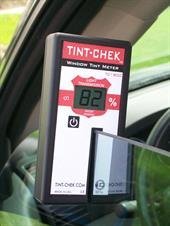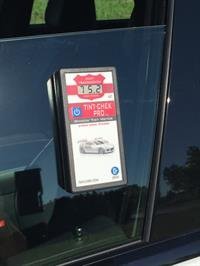How do tint meters work and where are they used?
How do tint meters work and where are they used? |
 | Visible light transmission (VLT) in tinted windows refers to the amount of visible light transmitted that is allowed to pass through
the window. So, when you see a window tint being referred to as a percentage, this refers to the VLT. So, if you see values
of 5% VLT, the tinted window is dark and only lets 5% of visible light through. While 80% VLT means the tinted window is light
and lets in 80% of visible light. The range of VLT is from 0% to 100% with a low reading indicating a small amount of light
passing through while a high reading indicates a large amount of light passing through.
| |
Tint meters work by shining a beam of light at 550 nanometers from the instrument sensor through the window to the optical sensor. As the beam is intercepted by the window, the meter will measure the amount of light that passes through and gives a reading in VLT. There are two types of tint meters available, horseshoe tint meters and tint meters with magnetic probes. Horseshoe shape
tint meters easily slide over the side windows to give a quick and easy reading. To measure VLT using a horseshoe shape tint meter,
ensure the window is clean of any dirt as this will affect the readings. Turn the meter on and wait until it reaches 100%
reading. Place the unit onto the window through the slot and within a couple seconds, there will be a VLT reading to give
you how much visible light passes through.
Tint meters with magnetic probes can measure VLT through the side, front and rear windows. It gives the user complete access to the
entire window that needs to be measured. To measure VLT using magnetic probes, ensure the window is clean of any dirt.
Turn the meter on and wait until it reaches 100% reading. Place the reflector probe one side of the window and place the
instrument probe on the other side of the window with the magnets lining up. Once the probes are aligned, the meter will
be able to then display a reading within a couple seconds.
Tint meters are generally used to calculate the VLT value after a car window has been tinted. The minimum VLT for both front and passenger windows that is legal and safe in Australia is 30-35% (dependent on each state). Tint meters are used by the police to ensure tinted windows are of a legal standard. Tint meters are also used by automotive workshops to ensure custom tinted windows are of legal standard. Testing VLT is important to ensure the driver’s visibility of other cars, cyclists, objects, and pedestrians aren't reduced and obscured. The Tint-Chek Window Tint Meter - IC-TC1800 is a horseshoe shape tint meter that is durable and highly accurate. The IC-TC1800 can take quick measurements and holds the value instantaneously. The IC-TC1800 also uses clever patent-pending techniques to eliminate light conditions such as stray headlights that affects a tint meters reading. The IC-TC1800 has an LCD backlight display so you can view the readings at night. These features are ideal for law enforcement officers to perform quick and accurate tint checks while on the job at any time. Figure 1: IC-TC1800 Tint-Chek Window Tint Meter The
Tint-Chek Pro 2-Piece Window Tint Meter - IC-TC3800 is a two piece tint meter that is ideal
to measure not only side windows but also front and rear windows. The two pieces give you the freedom to place the meter
anywhere that you require a measurement. Similar to the
IC-TC1800, the
IC-TC3800 is able to take quick and precise measurements with no effect to changing ambient
light conditions. The
IC-TC3800 is ideal for automotive workshops to test all the windows in a car to ensure they
meet state standards and for law enforcement officers to perform more extensive tests.
Figure 2: Tint-Chek Pro 2-Piece Window Tint Meter - IC-TC3800 If you wish to see the IC-TC3800 in use please click here. If you’re still unsure about which Tint meter is right for you, contact one of our scientists on 1300 737 871 or at
[email protected] | ||
See our other newsletter articles here!
Contact our expert scientists now to get the right meter or data logger to suit your needs and discuss your project.
Phone: 1300 737 871
Email: [email protected]


